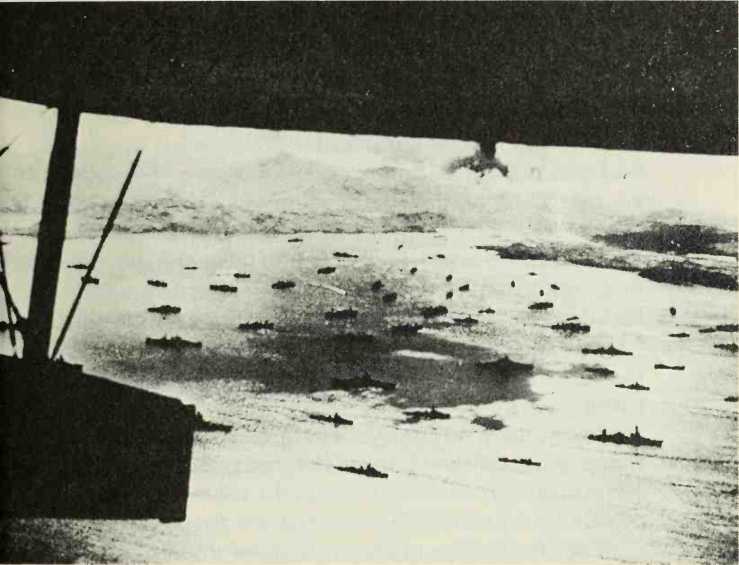In mid-may 1942, a huge invasion force of 200 ships, including eight aircraft carriers, left the home islands of Japan. The vessels were supported by 600 aircraft.
The Japanese ships and the men they carried had two objectives: to capture Midway Island, about 1,000 miles to the northwest of Hawaii, and to occupy the Aleutians, the long string of rocky, barren islands that extend south and west of Alaska.
In a two-day battle off Midway, the bulk of the Japanese fleet was severely mauled by American planes and suffered the loss of four aircraft carriers and a major part of its aircraft. No troops were put ashore. Experts say that Midway was the turning point that spelled Japan’s ultimate defeat.
The Japanese, however, did accomplish their goal in the Aleutian Islands. On June 7, a small force of Japanese landed and captured two of the Aleutians, Kiska and Attu.
The islands were of little strategic value. Usually covered by fog or battered by storms, they were virtually unusable as air or naval bases. But the Japanese occupation of the Aleutians had psychological value. It alarmed Alaskans and Americans hving in the Pacific Northwest. They felt the islands could serve as a launching point for further expansion. And Americans everywhere were indignant that the Japanese should be holding American territorial land. (Alaska entered the union in 1959.)
Almost a year later, on May 11, 1943, Americans landed a division of troops on Attu, which defeated the Japanese garrison after about two weeks of intense fighting. The Americans then turned their attention to Kiska. D-Day for the invasion was set for August 15.
During July two powerful task groups of American ships were assigned to waters south of Kiska. Their mission was to bombard enemy installations and destroy enemy vessels seeking to reinforce the island. One group of American vessels consisted of the battleships New Mexico and Mississippi, plus a pair of destroyers and a minesweeper. The second group boasted four heavy cruisers, the Wichita, Louisville, Portland, and San Francisco, the light cruiser Santa Fe, and a protecting screen of five destroyers. Rear Admiral Robert C. Griffen was in charge of both groups.
Toward the end of July Admiral Giffen received the news that the Japanese Fifth Fleet—two heavy cruisers, two light cruisers, and several destroyers—had left its home base in the Kuriles, the chain of small islands off the northeast coast of Asia that extends north from Japan. The Fleet’s destination was not known. However, a shore-based navy scout plane had reported a radar contact with several unidentified objects on the ocean’s surface about 315 miles southwest of Kiska. Were they the Japanese ships? Nobody knew for certain.
Foul weather hampered efforts to estabhsh contact with whatever ships might be in the area. Most days were shrouded with heavy fog. Lookouts on the ships could make out only the gray bulk of the ship dead ahead.
Not long after midnight on July 26, the two American naval groups were steaming about 80 miles south of Kiska. A layer of thick clouds blotted out all but a few stars. Suddenly the radar operator aboard the Mississippi spotted several “pips,” or bright dots of light, on the radar screen he was monitoring. The pips appeared to be a cluster of large ships about 15 mdes away. Similar reports began to come from the New Mexico, Portland, and Wichita.
Admiral Giffen wasted no time ordering the ships to general quarters. Sailors, roused from their sleep, hurriedly dressed and raced to their battle stations. Battleship guns were trained on the distant targets. Destroyers got into position to launch their torpedoes. Every ship set course for the enemy vessels.
The New Mexico's radar reported six pips. Other ships were less definite, but indicated several. The enemy ships were speeding along at 16 knots and appeared to be heading for Kiska Harbor.
It must be the Japanese Fifth Fleet, thought Admiral Giffen. “Commence firing,” he ordered. Gun flashes from the Wichita and the Portland were the

SHIPS OF ALEUTIAN ISLANDS INVASION FLEET ASSEMBLE AT ADAK HARBOR. (National Archives)
First to light the nighttime sky. Minutes later the New Mexico and Mississippi joined in the cannonading.
Several ships, however, stood grim and silent. Radar operators aboard the San Francisco and Santa Fe were unable to establish contact with the enemy ships. Their gunnery officers cursed the uncooperative radar equipment.
Admiral Giffen believed the Japanese ships were equipped with highly destructive “long lance” torpedoes, and he had no wish to get within range of them. So he kept his vessels three or four miles away, depending solely on radar to keep track of the vessels.
The firing continued for half an hour. Oddly, the vessels under attack were silent. No return fire could be heard. No gun flashes could be seen. No enemy searchhghts pierced the blackness.
The cruiser Portland, in an effort to actually see the enemy ships, fired a few starshells. They brightened several square miles of ocean as they hung in the black sky, but revealed not a single ship.
The destroyers, now poised to launch their torpedoes, kept reporting they were unable to spot anything.
Then, as mysteriously as they had appeared, the radar pips vanished from the radar screens of the Mississippi, New Mexico, and the other vessels. The puzzled Admiral Giffen ordered the firing to cease.
The two groups of ships steamed toward the area where the pips were believed to have originated. Four hours were spent in a careful search. No trace of the enemy was found—no oil, no debris, no survivors.
The following day an air search of the area could find no evidence of the enemy ships either. The Navy had fired 518 14-inch shells and 487 8-inch shells needlessly.
An investigation followed. According to one answer to the puzzle, the radar pips may have been caused by enemy submarines that dived when the shelling began. Another stated that whales may have been the reason for the radar contact. A third explanation blamed abnormal atmospheric conditions, known in the past to have made radar behave freakishly.
The American ships continued to bombard Kiska.
When the shelhng was over, some 34,000 troops were put ashore. They spent five days searching the island until they were convinced it was empty. The Japanese garrison had secretly evacuated Kiska more than two weeks before. Like “The Battle of the Pips,” the invasion of Kiska was a great victory, lacking only one element—an enemy!




 World History
World History









